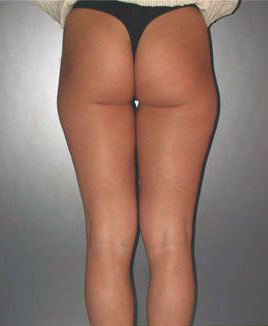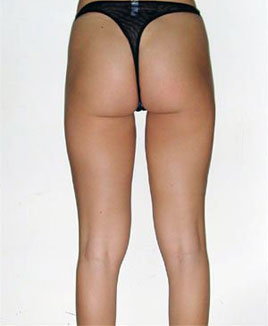LIPOSUCTION

Liposuction reshapes specific areas of your body by removing excess fat improving your body contours and proportions.
Inserting a thin cannula tube through a small incision previously made, a controlled back and forth movement loosens the extra fat.

Before intervention

After intervention
What problems can liposuction resolve
There are deposits of fat so-called stubborn fat, which are not able to eliminate even with the most drastic diets, exercise targeted to those areas, or anti-cellulite treatments. Typically, these deposits are exactly where the most nuisance is affecting not only the overall aesthetic impression of bodily proportions but also often causing deep psychological hardships.
Liposuction gives excellent results and long-lasting correction of the body. In particular deposits of fat from the hips, belly, ankles, chest, and under the chin are most successfully removed.
Who chooses liposuction does not decide only for aesthetic reasons.
There is no age limit to undergo this intervention, but it is better to run it until the skin is still elastic and tonic.
Liposuction is not a solution to correct the imperfections of cellulite.
What results expected from a liposuction
By eliminating localized fat deposits and reshaping these areas, the body appears leaner and more proportioned.
Attention, however, liposuction is not an alternative to a diet or treatment against bulimia. You can not simplify the whole body, but only individual areas with localized fat deposits.
If the skin is too relaxed the only solution is removing skin surplus with the fatty tissue (see abdominal plastic and lifting of the arms and thighs).
Anesthesia and recovery
Small interventions can be performed. Liposuction is done in the ambulatory of your plastic surgeon under local anesthesia. You can leave the clinic immediately after the procedure.
One particular technique used by us provides an injection of a liquid anesthetic in the area to be worked and that reduces the need for total anesthesia also measures of average size.
Surgeries that are more complicated need full anesthesia. Liposuction on hips and legs can also be carried out with anesthesia in the spine. Preliminary analyses with the anaesthesiologist will be made in the same clinic the day before.
The hospital time may last from 1 to 8 days.
Preparation
Communicate to your surgeon if you suffer from allergies or other chronic diseases. If you bruise easily or bleed excessively in the case of small wounds you may require some analysis to exclude difficulties of your blood to clot.
There are aspirin-type painkillers that should not be taken during the two weeks before the intervention because their active ingredient interferes with blood clotting and can cause excessive bleeding. And you must avoid all alcohol and sleeping pills.
Get an elastic sheath suited for the objective area and bring it with you on the day of the intervention
Intervention process
Before the treatment, the plastic surgeon decides how to remodel the areas that need to be thinned by marking isometric lines around the deposits of fat.
A small incision is made about 0.4cm long in a little not evident point like the navel or natural folds of the body. A sterile liquid is injected that contains local anesthesia and vasoconstrictors that reduces bleeding.
After about 10 minutes a thin tube connected to a suction machine is placed inside the incision. With precise movements back and forth, the surgeon models the tissues in a uniform way breaking the fatty tissue and excess fat.
Depending on the amount of fat to be taken, this stage can last from 20 minutes up to 2 hours or more. The fat taken is stored and weighed accurately to get a symmetrical result at the end.
At the end of the process, the doctor proceeds to suture the incision.
The part is made slightly compressed by a sheath or an elastic bandage to prevent the accumulation of fluid in the empty spaces and causing knots or scars or other irregularities.
What happens after surgery
Immediately after the intervention, you should expect slight pain and minor bruising. Slowly these symptoms will fade within a few days or weeks.
Swelling in the operated area is normal after the surgery, and can last from 6 weeks to 6 months in extreme cases.
The result is not assessed before 6-9 months after the operation.
The points of the suture are removed after one week.
The scars fade over time and become almost invisible.
Possible risks and complications
The risks and complications of liposuction are rare but they increase with the amount of fat sucked.
After liposuction, there could be an insensitivity to the touch in the areas affected.
There are risks of bruising or scarring if you do not keep your sheath or elastic bandages constantly or even if there is a personal tendency. This complication occurs with the roughness of the skin. If they do not heal on their own within a few weeks we will proceed with surgery.
Removal of a large amount of fat tissue can cause considerable excessive loss of bodily fluids or blood. In this case, the remedy is an infusion of physiological fluid or blood transfusion.
Very rare cases of embolism have been reported and these cases require intensive medical treatment.
However, the relation between liposuction and embolism is not sure and so we mention it only for clarity.
The intervention is not recommended in cases of diabetes, circulation problems, problems with the heart or lung and the treatment area, or has undergone recent surgery.
Precautions after surgery
It is important to keep the sheathing or elastic bandage day and night for the first 6 weeks after surgery to avoid possible complications.
Normally you feel fully fit almost immediately after the procedure. The recovery time is very personal and depends on the size of the intervention.
It is best to reduce the sport activity in the weeks following the intervention. Also, avoid massage or other physical activities.
Cold showers instead stimulate circulation and can accelerate the healing process.
